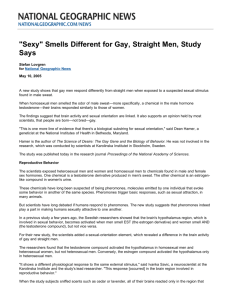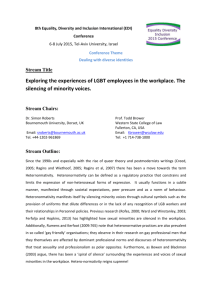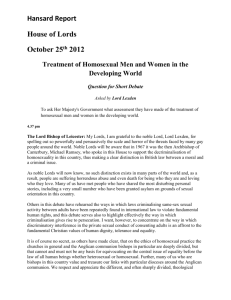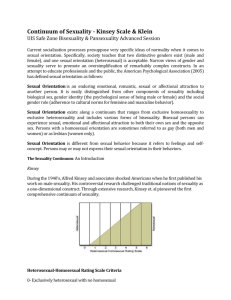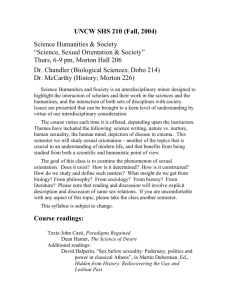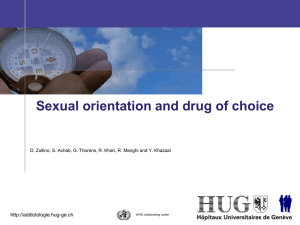File
advertisement
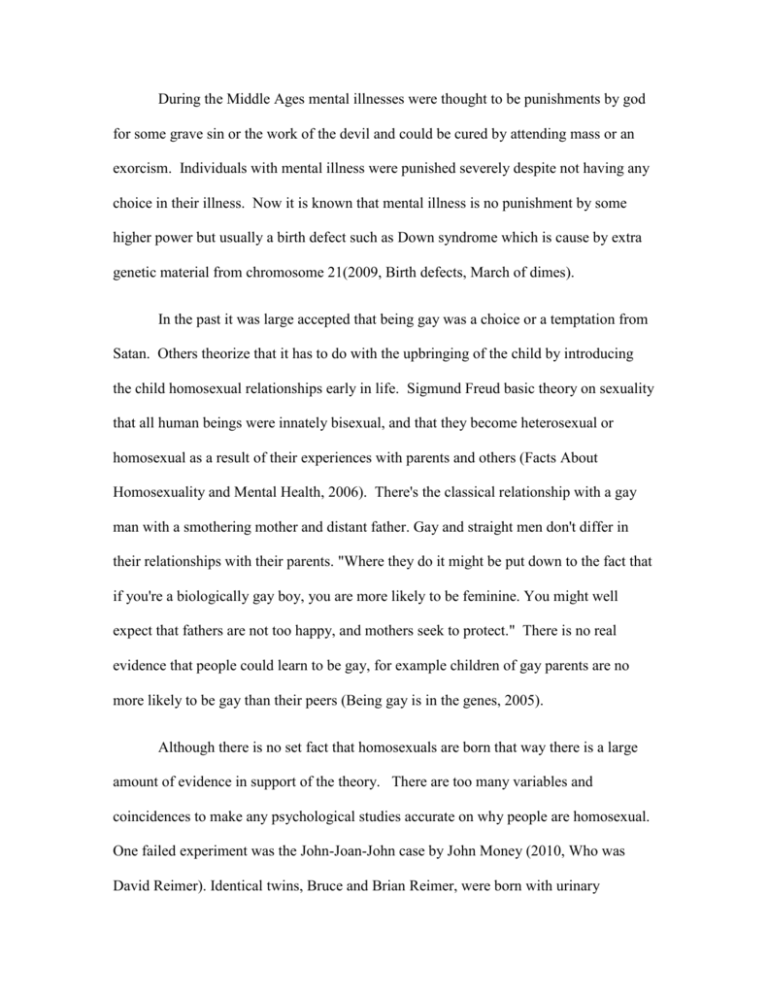
During the Middle Ages mental illnesses were thought to be punishments by god for some grave sin or the work of the devil and could be cured by attending mass or an exorcism. Individuals with mental illness were punished severely despite not having any choice in their illness. Now it is known that mental illness is no punishment by some higher power but usually a birth defect such as Down syndrome which is cause by extra genetic material from chromosome 21(2009, Birth defects, March of dimes). In the past it was large accepted that being gay was a choice or a temptation from Satan. Others theorize that it has to do with the upbringing of the child by introducing the child homosexual relationships early in life. Sigmund Freud basic theory on sexuality that all human beings were innately bisexual, and that they become heterosexual or homosexual as a result of their experiences with parents and others (Facts About Homosexuality and Mental Health, 2006). There's the classical relationship with a gay man with a smothering mother and distant father. Gay and straight men don't differ in their relationships with their parents. "Where they do it might be put down to the fact that if you're a biologically gay boy, you are more likely to be feminine. You might well expect that fathers are not too happy, and mothers seek to protect." There is no real evidence that people could learn to be gay, for example children of gay parents are no more likely to be gay than their peers (Being gay is in the genes, 2005). Although there is no set fact that homosexuals are born that way there is a large amount of evidence in support of the theory. There are too many variables and coincidences to make any psychological studies accurate on why people are homosexual. One failed experiment was the John-Joan-John case by John Money (2010, Who was David Reimer). Identical twins, Bruce and Brian Reimer, were born with urinary difficulties so doctors suggested circumcision in order to solve the problem. The medical team had used an unconventional technique of cauterization with an electric burning device that accidentally destroyed Bruce's penis with no possibility that it could be surgically reconstructed. The Reimers learned of a psychologist John Money of Johns Hopkins University in Baltimore, who was convinced that children could be educated to become girls, this psychologist defended the idea that it was education and the surrounding environment which determines the gender identity of children, rather than default prenatal biological factors. Money claimed that everyone is born gender-neutral and it take’s direction and shape as we grow towards the identity of woman or man. Money believed that gender roles are social configurations (2010, Who was David Reimer?). The parents agreed to have sex reassignment surgery at the age of 21 months. Bruce, who was renamed Brenda, was raised like any female child, learning about how to apply make and women should behave. Growing up Brenda never liked playing with dolls or other activities girls her age did, and found himself attracted to women. In the words of his own twin brother, Brian: "the only difference between my brother Bruce and me is that he had long hair while mine was short. In everything else we were equal." Brenda's mother, Janet said: "I tried to do everything I could with all my efforts to convince Brenda he was female but that did not happen, it was impossible, he always felt a boy."(2010, Who was David Reimer?) The experiment a huge failure despite John Moneys attempts to influence Bruce into believe he was a female and caused the later suicide of Bruce at the age of 38 . Providing evidence that social aspects do not decide someone's sexual orientation, and in attempting to change it results in failure and causes psychological issues. One of the most accurate theories is the Fraternal birth order effect which states that the more older brother a man has, the greater probability is he will have homosexual orientation (Fraternal birth order and male sexual orientation, 2012). The number of biological older brothers, including those not reared with the participant (but not the number of nonbiological older brothers), increases the probability of homosexuality in men. These results provide evidence that a prenatal mechanism(s), and not social and/or rearing factors, affects men's sexual orientation development. (2006, Anthony Bogaert, The Proceedings of the Nations Academy of Sciences) This is not due to being raise with older brothers, but is hypothesized that the mother's immune system recognizes these male-specific molecules as foreign and starts producing antibodies to them. The more boys the woman produces increases the effect of estrogen on the fetus making it 33% chance of being homosexual after the first boy (Fraternal birth order and male sexual orientation, 2012). This is believed to be the cause of about 15% of homosexuals. These results support a prenatal origin to sexual orientation development in men and indicate that the fraternal birth-order effect is probably the result of a maternal memory for male births (2006, Anthony Bogaert, The Proceedings of the Nations Academy of Sciences). In 1991, Dr. Simon LeVay reported his findings from studying the brain structures of forty-one cadavers containing 6 women, 19 homosexual men, and 16 heterosexual men. (1991, Simon LeVay, page. 1034–37) He concluded that an area of the hypothalamus (INAH3) was smaller in homosexual men than in heterosexual men and was about the same size as heterosexual woman. The hypothalamus is a region of the brain that contains several types of neurons responsible for secreting different hormones (2011, Hormones of the Hypothalamus). Gonadotropin-releasing hormones secretion at the beginning of puberty triggers sexual development, and from then on it is essential for normal sexual physiology in both males and females. The size difference in the INAH3 could cause the amount and type of hormone released into the body effecting sexual development and attractions. Swedish researchers have shown that homosexual and heterosexual men respond differently to two odors that may be involved in sexual arousal, and that the gay men respond in the same way as women (2005, Gay men are found to have different scent of attraction). The two chemicals in the study were a testosterone derivative produced in men's sweat and an estrogen-like compound in women's urine, both of which have been suspected of being pheromones. Pheromones, chemicals emitted by one individual to evoke some behavior in another of the same species. The pheromones trigger the hypothalamus releasing hormones into the body creating the sexual attraction. "The big question is not where homosexuality comes from, but where does sexuality come from," said Dr. Dean Hamer, a geneticist at the National Institutes of Health(2005, Gay men are found to have different scent of attraction). The different pattern of activity that brains of gay men could be either a cause of their sexual orientation or an effect of it. If sexual orientation has a genetic cause, or is influenced by hormones in the womb or at puberty, then the neurons in the hypothalamus could wire themselves up in a way that permanently shapes which sex a person is attracted to.



